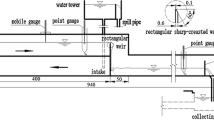Conclusions
-
1.
An original complete method of hydraulic calculation of rapids with intensified roughness was developed on the basis of the author's multiple-aspect experimental studies and his earlier developed [7, 8, 9, 10, 17] system of universal dependences and hypotheses concerning hydraulic resistances (15), stabilized aeration (9), velocity of the liquid phase (10), and critical aeration states (7).
-
2.
An important component of the new method is the formula of the resistance coefficient (24), the structure of which follows from (15), and the relative reduced height of the ribs is used as the argument. Thanks to such a combination, the values of the constants of formula (24) for ribs placed only on the bottom and of ribs placed on the entire perimeter were unified and the “effect of width” known in hydraulics was overcome. The values of the constants of formula (24) for the six investigated types of ribs are given in Table 3.
-
3.
The new method has also a way to calculate chutes with zigzag ribs with an unlimited (n>2) number of zigzags on the basis of a standard calculation for n′=2, using relations (33). Relation (40) for assigning the minimum (for a given b) number of zigzags not leading to disturbance of the normal distribution of velocities and depths at the entry to the discharge canal was also substantiated preliminarily.
-
4.
The problems solved in the work, in which the initial data of laboratory (unaerated flows) and on-site (aerated flows) investigations were used for comparing the results of calculations by the new method with the actual values of the quantities being sought show that calculation by the new method of the indicated quasi-uniform flows and parameters of the ribs on chutes with intensified roughness reduces to simple operation taking several lines on the basis of the Chezy (or Darcy) formula, dependences (7), (9), (10), (12), and formula (24). The results of these calculations in all cases are exceptionally close to the actual values of the quantities being sought, which indicates the engineering reliability of the new method.
-
5.
The significance of the correspondence of the calculation results to the actual data noted in the preceding paragraph goes beyond the bounds of the new method, since it, by a completely specific example, confirms the universality of the dependences (7), (9), (10), (15), developed earlier and approved prior to this on objects of other categories, used in the calculations.
-
6.
The new method, taking into account the universality of the formulas underlying it, the wide limits of its experimental base and approval, is recommended for using in the entire engineering range. Restrictions are related only to formula (24), since the values of its experimental constants, given in Table 3, are real when conditions (1) and (2) are fulfilled. We recommend also in practical calculations staying in the intervals of values of Δ/h0 indicated in Table 3 and which per se are sufficiently wide.
Similar content being viewed by others
References
E. A. Zamarin, “Artificial roughness,” Nauchn. Zap. MIIVKh, Sel'khozgiz, Moscow, No. 1 (1935).
F. I. Pikalov, “Chutes with artificial roughness,” Tr. VNIIGiM, Sel'khozgiz, Moscow,13 (1935).
O. M. Aivazian, “New method of hydraulic calculation of chutes with intensified roughness,” Tr. MGMI, Moscow,52 (1977).
P. G. Kiselev (editor), Handbook of Hydraulic Calculations [in Russian] Énergiya, Moscow (1972).
P. I. Gordienko, “Hydraulic resistance during rapid flows in rough channels,” in: Transactions of Joint Conferences on Hydraulic Engineering [in Russian], Énergiya, Moscow-Leningrad, No. 52 (1969).
V. P. Nedriga (ed.), Designer's Handbook. Hydraulic Structures [in Russian], Stroiizdat, Moscow (1983).
O. M. Aivazian, “Stabilized aeration on chutes,” Gidrotekh. Stroit., No. 12 (1986).
O. M. Aivazian, “Hydraulic resistance and capacity of uniform aerated and unaerated rapid flows in concrete channels,” Gidrotekh. Stroit., No. 6 (1992).
O. M. Aivazian, “Universal index of critical aeration states of uniform and nonuniform flows,” Gidrotekh. Stroit., No. 9 (1994).
O. M. Aivazian, “Stability criterion of laminar flow,” Gidrotekh. Stroit., No. 12 (1985).
Yu. D. Levchenko, M. N. Meshkov, and Yu. P. Trubakov, “Hydraulic resistance during viscous fluid flow in rough tubes,” in: Heat Exchanges and Power Equipment of Nuclear Power Stations [in Russian], Nauka, Leningrad (1987).
O. M. Aivazian, “Properties of turbulent channel flows in stretches with separated flow,” Izv. Akad. Nauk Arm. SSR, Ser. Tekh. Nauk,10, No. 2 (1957).
O. M. Aivazian, “Investigation of the turbulent mixing coefficient in the boundary layer of two-dimensional channel flows,” Izv. Akad. Nauk Arm, SSR, Ser. Tekh. Nauk,12, No. 3 (1959).
O. M. Aivazian, “Free boundary layer of a steady channel flow and its properties,” in: Problems of Hydraulics [in Russian], MGMI, Moscow (1969).
L. G. Loitsyanskii, Fluid Mechanics [in Russian], Nauka, Moscow (1987).
O. M. Aivazian and A. M. Karimov, “Experimental investigation of the parameters of uniform rapia flows at the time of occurrence of aeration,” Gidrotekh. Stroit., No. 7 (1993).
O. M. Aivazian, Investigation of tranquil and rapid flows in smooth-walled and reinforced-concrete flume channels,” Gidrotekh. Stroit., No. 2 (1984).
R. E. Adigalov, Improvement of the Designs and Methods of Hydraulic Research and Calculation of Chutes with Artificia Roughness, Candidate Dissertation Abstract, Moscow (1991).
SNiP 2.06.03-85, Reclamation Systems and Structures [in Russian], Gosstroi SSR, Moscow (1986).
H. Bazin, Recherches hydrauliques, Comptes rendus de l'Academie des Sciences, Paris (1865).
L. G. Straub and A. G. Anderson, “Experiments on self-aerated flows in open channels,” in: Proc. ASCE, paper 1890, HY7 (1958).
O. Aivazian and M. Armengol, “Modelo del aliviadero del hidroconpunto Los Palacios,” Volutad Hidraulica, No. 26 (1973).
O. Aivazian, “Calculo hidraulico de rapides con rugosidad intensificada” Voluntad Hidraulica, No. 25 (1973).m
Additional information
Translated from Gidrotekhnicheskoe Stroitel'stvo, No. 6, pp. 27–39, June, 1996.
Rights and permissions
About this article
Cite this article
Aivazian, O.M. New investigations and new method of hydraulic calculation of chutes with intensified roughness. Hydrotechnical Construction 30, 335–356 (1996). https://doi.org/10.1007/BF02443117
Issue Date:
DOI: https://doi.org/10.1007/BF02443117




